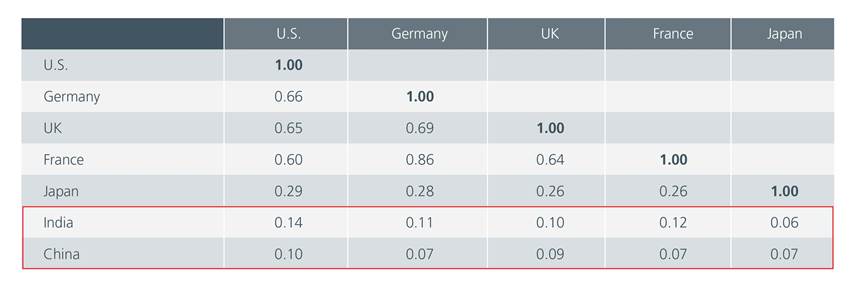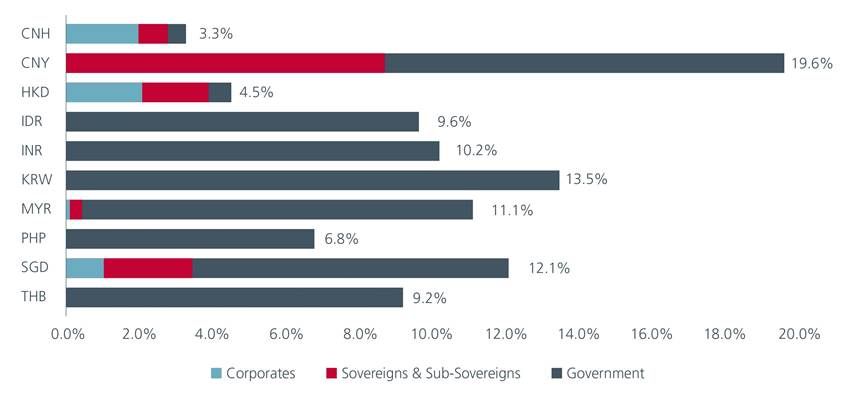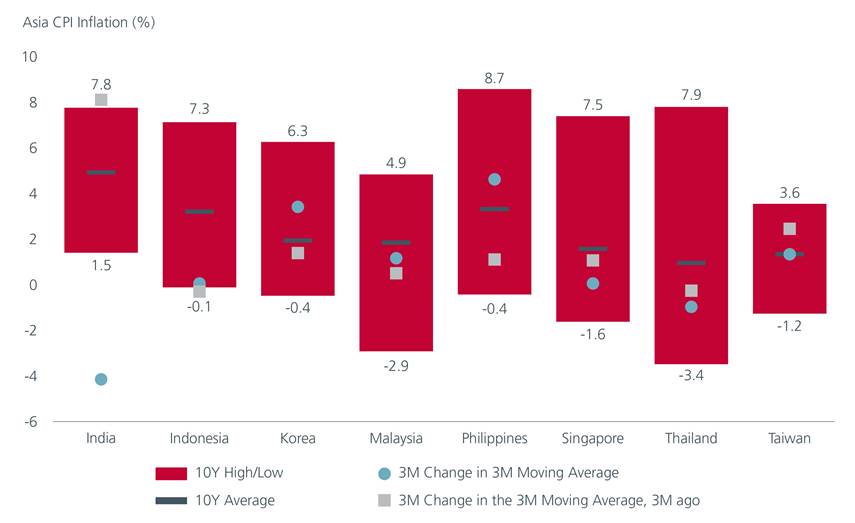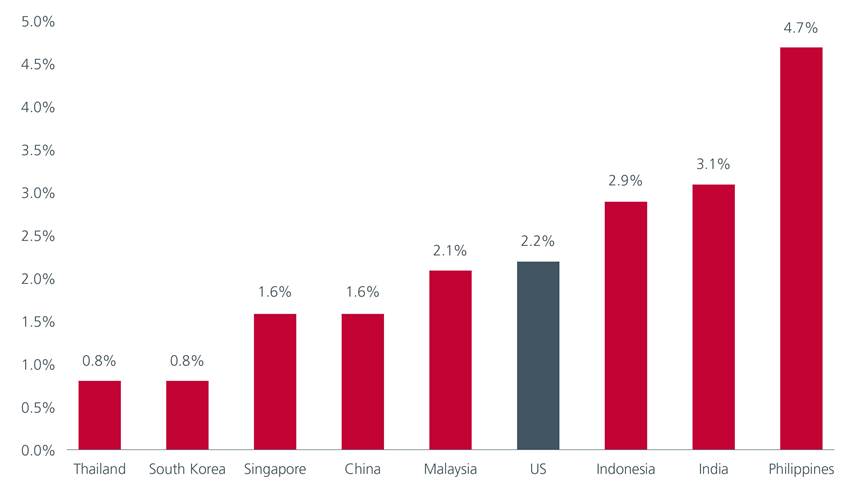Executive Summary
- Concerns over the sustainability of the US’ fiscal deficit and potentially a weaker USD are reducing the attractiveness of US Treasuries.
- Asia local currency bonds offer diversification benefits, with low to moderate correlations to major developed market bonds.
- With inflation subdued across Asia, and high real yields, now may be the time for investors to explore the potential of Asia’s local bond markets.
In a world of shifting macroeconomic tides, Asia’s local currency bond markets are emerging as a compelling destination for global investors. The confluence of a rising US fiscal deficit, weakening US dollar, subdued inflation across much of Asia, and higher real yields in the Asia region is creating a favourable backdrop for these assets. For investors seeking diversification, income, and resilience, the case for Asia local currency bonds has rarely been stronger.
US’ rising fiscal deficit redefines the playing field
In our mid-year outlook, we noted that the new US budget may have negative long-term implications for US Treasuries. At the same time, while the USD would probably maintain its reserve currency status for the foreseeable future, concerns over weaker US growth, the sustainability of the US’ fiscal deficit and growing geopolitical tensions have all contributed to a reassessment of the USD’s dominance. We believe that this is likely to drive some further repatriation of funds out of the USD over the next year.
Asian currencies are likely to strengthen as a result. In recent months, the USD has depreciated against most major currencies, including those in Asia. See Fig. 1. This trend enhances the appeal of local currency bonds for foreign investors, as currency appreciation can amplify total returns. Moreover, as the USD weakens, the relative attractiveness of US Treasuries and other US assets diminishes, potentially prompting investors to diversify and seek alternatives with better risk-reward profiles. Asia currency exposure may also be attractive to USD investors who are looking to diversify.
Fig. 1. Asian currency movements against the USD (year to date)

Source: Bloomberg. As of 15 May 2025.
Asia local currency bonds offer diversification benefits as they exhibit low to moderate correlations to US Treasuries and to other major developed market peers. This is increasingly valuable in today’s volatile environment. Fig. 2.
Fig. 2. Correlations between bond yields, 1995 to 2025

Source: Bloomberg, IIF. May 2025.
The asset class has also matured significantly. As of end April 2025, the outstanding value of local currency bonds in Asia reached USD 1339 bn, comprising over 2000 issues from more than 390 issuers.1 The size of the market reflects not only the region’s economic growth but also regulatory reforms and increased foreign participation. As more Asia local currency bonds get included in global benchmarks, passive flows are likely to rise, further supporting valuations. For example, India government bonds were included in the JP Morgan Government Bond Index – Emerging Markets from 2024 while South Korea's government bonds are set to be included in the FTSE Russell World Government Bond Index starting in April 2026.
Asian sovereigns are key issuers in local currency bond indices. With many of Asia’s government bond markets having investment-grade ratings, they potentially offer investors both quality and yield. Fig. 3. Corporate issuers are relatively more active in China, Malaysia, Singapore and Thailand. Fig. 4.
Fig. 3. Asia – ratings (Moody’s)

Source: Moody’s as of 30 April 2025.
Fig. 4. Sector breakdown by currency

Source: Eastspring Investments. Markit iBoxx ALBI Index. As at 30 April 2025. Due to rounding, the numbers presented may not add up to the totals indicated and the percentages may not reflect the absolute figures for the same reason. The chart above is for illustrative purposes and may not be indicative of the future or likely performance of the markets.
Real yields: Asia’s quiet advantage
While inflation remains sticky in the US and parts of Europe, Asia tells a different story. Central banks in the region have largely succeeded in anchoring inflation expectations. Fig. 5. In India, for instance, inflation has declined to a six-year low of 3.2% year-on-year, driven by falling food prices. Similarly, in the Philippines, inflation is subdued, with weak domestic demand allowing the central bank to maintain a dovish stance.
Fig. 5. Asia inflation appears contained

Source: LSEG Datastream. May 2025.
Moderate inflation gives Asian central banks room to maneuver. In 2025 to date, central banks in India, Indonesia, Korea, Singapore, China, Philippines and Thailand have already cut rates or eased. More easing is expected going forward. This policy flexibility supports bond prices and provides a stable environment for income-seeking investors.
With inflation under control and nominal yields still elevated, real yields in Asia are among the most attractive globally. For example, real yields in Indonesia, India and Philippines are currently higher than the US’. Fig. 6.
Fig. 6. Asia vs US real yields

Source: Bloomberg. May 2025. Inflation data as of latest available. Yields may be an estimation in some instances, as some local currency bonds have wide bid-asks.
This yield advantage is not just a function of policy rates. It reflects deeper structural strengths such as prudent fiscal management, improving credit fundamentals, and growing domestic investor bases.
Besides tailwinds from potential rate cuts, many of the markets also enjoy idiosyncratic drivers such as strong domestic demand in Indonesia, Malaysia, India, South Korea and China. Meanwhile, Singapore, one of the few remaining AAA-rated government bond markets in the world, enjoys a safe haven status given its low volatility and high credit rating.
A timely opportunity
Asia local currency bonds offer a rare combination of yield, stability, and diversification. As the global economic order evolves, these assets can play a key role in global bond portfolios. With the US dollar under pressure, inflation subdued across Asia, and high real yields, now may be the time for investors to take a closer look at what Asia’s local bond markets have to offer. In markets like Indonesia and Malaysia to a lesser extent, steep yield curves offer opportunities for duration plays, especially ahead of anticipated rate cuts. In the near term, market volatility—driven by trade tensions, geopolitical risks, and uncertain US trade policy—may create entry points for nimble active investors.
Sources:
1 Markit iBoxx ALBI (USD unhedged).
The information and views expressed herein do not constitute an offer or solicitation to deal in shares of any securities or financial instruments and it is not intended for distribution or use by anyone or entity located in any jurisdiction where such distribution would be unlawful or prohibited. The information does not constitute investment advice or an offer to provide investment advisory or investment management service or the solicitation of an offer to provide investment advisory or investment management services in any jurisdiction in which an offer or solicitation would be unlawful under the securities laws of that jurisdiction.
Past performance and the predictions, projections, or forecasts on the economy, securities markets or the economic trends of the markets are not necessarily indicative of the future or likely performance of Eastspring Investments or any of the strategies managed by Eastspring Investments. An investment is subject to investment risks, including the possible loss of the principal amount invested. Where an investment is denominated in another currency, exchange rates may have an adverse effect on the value price or income of that investment. Furthermore, exposure to a single country market, specific portfolio composition or management techniques may potentially increase volatility.
Any securities mentioned are included for illustration purposes only. It should not be considered a recommendation to purchase or sell such securities. There is no assurance that any security discussed herein will remain in the portfolio at the time you receive this document or that security sold has not been repurchased.
The information provided herein is believed to be reliable at time of publication and based on matters as they exist as of the date of preparation of this report and not as of any future date. Eastspring Investments undertakes no (and disclaims any) obligation to update, modify or amend this document or to otherwise notify you in the event that any matter stated in the materials, or any opinion, projection, forecast or estimate set forth in the document, changes or subsequently becomes inaccurate. Eastspring Investments personnel may develop views and opinions that are not stated in the materials or that are contrary to the views and opinions stated in the materials at any time and from time to time as the result of a negative factor that comes to its attention in respect to an investment or for any other reason or for no reason. Eastspring Investments shall not and shall have no duty to notify you of any such views and opinions. This document is solely for information and does not have any regard to the specific investment objectives, financial or tax situation and the particular needs of any specific person who may receive this document.
Eastspring Investments Inc. (Eastspring US) primary activity is to provide certain marketing, sales servicing, and client support in the US on behalf of Eastspring Investment (Singapore) Limited (“Eastspring Singapore”). Eastspring Singapore is an affiliated investment management entity that is domiciled and registered under, among other regulatory bodies, the Monetary Authority of Singapore (MAS). Eastspring Singapore and Eastspring US are both registered with the US Securities and Exchange Commission as a registered investment adviser. Registration as an adviser does not imply a level of skill or training. Eastspring US seeks to identify and introduce to Eastspring Singapore potential institutional client prospects. Such prospects, once introduced, would contract directly with Eastspring Singapore for any investment management or advisory services. Additional information about Eastspring Singapore and Eastspring US is also is available on the SEC’s website at www.adviserinfo.sec. gov.
Certain information contained herein constitutes "forward-looking statements", which can be identified by the use of forward-looking terminology such as "may", "will", "should", "expect", "anticipate", "project", "estimate", "intend", "continue" or "believe" or the negatives thereof, other variations thereof or comparable terminology. Such information is based on expectations, estimates and projections (and assumptions underlying such information) and cannot be relied upon as a guarantee of future performance. Due to various risks and uncertainties, actual events or results, or the actual performance of any fund may differ materially from those reflected or contemplated in such forward-looking statements.
Eastspring Investments companies (excluding JV companies) are ultimately wholly-owned / indirect subsidiaries / associate of Prudential plc of the United Kingdom. Eastspring Investments companies (including JV’s) and Prudential plc are not affiliated in any manner with Prudential Financial, Inc., a company whose principal place of business is in the United States of America.














